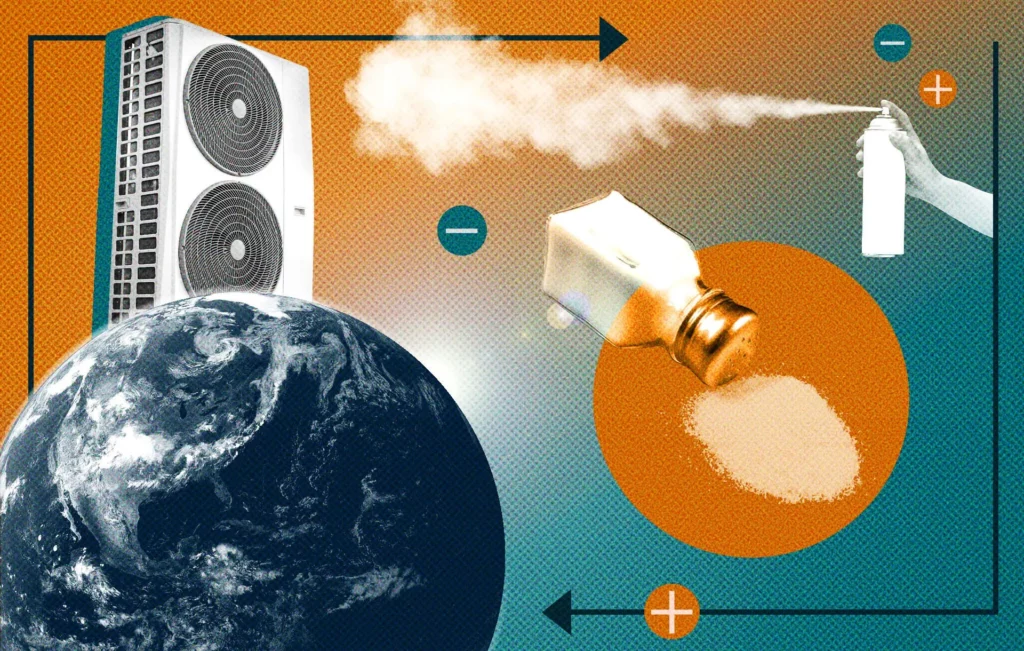
During winter, you’ll often see municipal trucks spray salt on roads and sidewalks to clear them of snow. Although no heat is added, the dissolution of the salt effectively lowers the freezing point of water, which explains why the ice melts even in sub-zero temperatures. And since the natural world is guided by energy conservation, the melting ice cools its environment.
Remarkably, no energy input is required for this to happen, which gave some scientists a cool idea. In a new study, researchers at the Department of Energy’s Lawrence Berkeley National Laboratory in the U.S. have used this exact physical principle to develop a new refrigeration device that cools stuff in an entirely different way compared to your kitchen fridge. This new method is believed to be not only more energy efficient but also much friendlier to the environment because conventional refrigeration hinges on extremely potent greenhouse gases as their cooling agent.
How ionocaloric cooling works
Similarly to conventional refrigeration, the new cooling technique in question, called “ionocaloric cooling”, exploits the fact that heat is absorbed or released when materials change phase, such as going from solid ice to liquid water. In order for ice to melt, it must absorb heat from its surroundings and when water freezes solid, it releases heat into the environment.
In an ionocaloric device, this phase change comes about not by pressurizing or heating a material but rather through the flow of ions, which are electrically charged atoms or molecules.

When an electric field is applied to a material, the ions within that material experience a force and begin to move. This movement causes a change in the material’s entropy, which leads to a change in temperature. By applying and removing an electric field in a controlled manner, it is possible to use the ionocaloric effect to produce cooling or heating. Tada!
But is this method actually feasible? After refining the theory underlying the ionocaloric cycle and demonstrating the technique experimentally, the physicists at the Berkeley Lab sure think so.
“The landscape of refrigerants is an unsolved problem: No one has successfully developed an alternative solution that makes stuff cold, works efficiently, is safe, and doesn’t hurt the environment,” said Drew Lilley, a graduate research assistant at Berkeley Lab and PhD candidate at UC Berkeley who led the study. “We think the ionocaloric cycle has the potential to meet all those goals if realized appropriately.”
The ionocaloric device is a solid-state technology that uses ionic motion, in contrast to conventional cooling that relies on the phase change of a liquid to absorb heat and produce cooling. No compressor or expansion valves, nor any moving parts are required, meaning an ionocaloric refrigerator is potentially more energy-efficient, environmentally friendly and capable of quickly heating or cooling depending on the situation, and can cover a wider range of temperatures.
| Feature | Ionocaloric Cooling | Conventional Refrigeration |
|---|---|---|
| Energy efficiency | Potentially more efficient | Can be relatively inefficient |
| Environmental impact | Does not rely on refrigerants | Can have a significant environmental impact if refrigerants are released into the atmosphere |
| Temperature range | Not limited | Typically used for cooling temperatures between -20 and 40 °C |
| Speed | Can be activated and deactivated quickly | Can take some time to cool or heat up |
| Size | More compact and portable | Can be relatively large and bulky |
The future of cooling
The team of researchers performed experiments using a salt made of iodine and sodium to melt ethylene carbonate crystals, an organic solvent routinely used in Li-ion batteries. Using just a single volt of charge, the system temperature difference of a whopping 25 degrees Celsius (45 degrees Fahrenheit).
The new study also mentions that the ionocaloric cycle has the potential to compete with or even exceed the efficiency of gaseous refrigerants found in the majority of systems today. Additionally, by using a material like ethylene carbonate, which can be produced by using carbon dioxide as an input, the refrigerant could have a negative global warming potential, meaning it could actually remove carbon from the atmosphere.
This is particularly important seeing how many countries are struggling to meet climate change goals, such as those in the Kigali Amendment (accepted by 145 parties, including the United States in October 2022). The agreement commits signatories to reduce the production and consumption of hydrofluorocarbons (HFCs) by at least 80% over the next 25 years. HFCs are powerful greenhouse gases commonly found in refrigerators and air conditioning systems.
“There’s potential to have refrigerants that are not just GWP [global warming potential]-zero, but GWP-negative,” Lilley said. “Using a material like ethylene carbonate could actually be carbon-negative, because you produce it by using carbon dioxide as an input. This could give us a place to use CO2 from carbon capture.”
The ionocaloric cycle can also be run in reverse to produce heating for both residential and industrial applications. Right now, the team is busy optimizing the ionocaloric cycle in order to improve its efficiency as well as its scaling potential so it can support large amounts of cooling demanded by the industry.
“We have this brand-new thermodynamic cycle and framework that brings together elements from different fields, and we’ve shown that it can work,” said Ravi Prasher, a research affiliate in Berkeley Lab’s Energy Technologies Area and adjunct professor in mechanical engineering at UC Berkeley. “Now, it’s time for experimentation to test different combinations of materials and techniques to meet the engineering challenges.”
The findings appeared in the journal Science.









